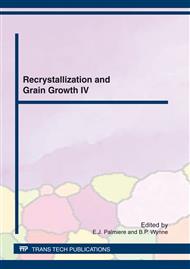p.51
p.61
p.62
p.73
p.81
p.89
p.96
p.102
p.103
Modeling the Flow Curve of Hot Deformed Austenite
Abstract:
A 0.02%C plain carbon and a 0.22%C TRIP steel were tested in compression in the temperature range 900°C to 1150°C and strain rate range 0.05s-1 to 1s-1. Thirty-two experimental flow curves were obtained in this way. The critical conditions for the initiation of dynamic recrystallization were determined by the double differentiation method. Using a dislocation density model to describe the austenite flow stress, the work hardening parameters r and h were derived and are used to model the flow curve in the absence of dynamic recrystallization. The latter was employed to calculate the fractional softening attributable to dynamic recrystallization. The kinetics of dynamic recrystallization are then described using Avrami kinetics. Finally, the dependences of the Avrami and work hardening parameters on Z, the Zener-Hollomon parameter, are used to model compression flow curves at strain rates an order of magnitude greater than the ones employed in the tests.
Info:
Periodical:
Pages:
81-88
Citation:
Online since:
April 2012
Authors:
Price:
Сopyright:
© 2012 Trans Tech Publications Ltd. All Rights Reserved
Share:
Citation:


